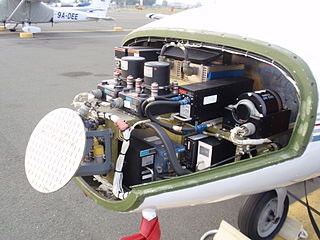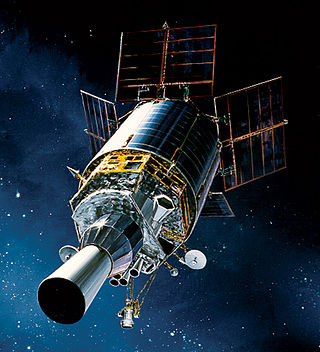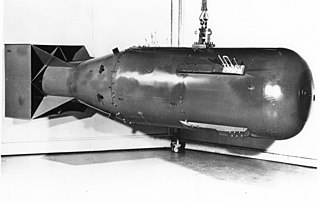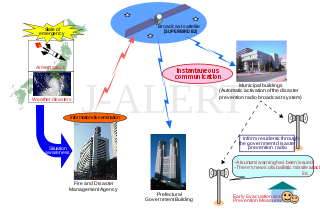
Avionics are the electronic systems used on aircraft. Avionic systems include communications, navigation, the display and management of multiple systems, and the hundreds of systems that are fitted to aircraft to perform individual functions. These can be as simple as a searchlight for a police helicopter or as complicated as the tactical system for an airborne early warning platform.

North American Aerospace Defense Command, known until March 1981 as the North American Air Defense Command, is a combined organization of the United States and Canada that provides aerospace warning, air sovereignty, and protection for Canada and the continental United States.

The Defense Support Program (DSP) is a program of the United States Space Force that operated the reconnaissance satellites which form the principal component of the Satellite Early Warning System used by the United States.

A tsunami warning system (TWS) is used to detect tsunamis in advance and issue the warnings to prevent loss of life and damage to property. It is made up of two equally important components: a network of sensors to detect tsunamis and a communications infrastructure to issue timely alarms to permit evacuation of the coastal areas. There are two distinct types of tsunami warning systems: international and regional. When operating, seismic alerts are used to instigate the watches and warnings; then, data from observed sea level height are used to verify the existence of a tsunami. Other systems have been proposed to augment the warning procedures; for example, it has been suggested that the duration and frequency content of t-wave energy is indicative of an earthquake's tsunami potential.

An emergency population warning, or public warning system is a method where by local, regional, or national authorities can contact or notify members of the public to warn them of an impending emergency. These warnings may be necessary for a number of reasons, including:
A false alarm, also called a nuisance alarm, is the deceptive or erroneous report of an emergency, causing unnecessary panic and/or bringing resources to a place where they are not needed. False alarms may occur with residential burglary alarms, smoke detectors, industrial alarms, fire alarms and in signal detection theory. False alarms have the potential to divert emergency responders away from legitimate emergencies, which could ultimately lead to loss of life. In some cases, repeated false alarms in a certain area may cause occupants to develop alarm fatigue and to start ignoring most alarms, knowing that each time it will probably be false. Intentionally falsely activating alarms in businesses and schools can lead to serious disciplinary actions, and criminal penalties such as fines and jail time.

In nuclear strategy, a retaliatory strike or second-strike capability is a country's assured ability to respond to a nuclear attack with powerful nuclear retaliation against the attacker. To have such an ability is considered vital in nuclear deterrence, as otherwise the other side might attempt to try to win a nuclear war in one massive first strike against its opponent's own nuclear forces.
Northrop Grumman Electronic Systems (NGES) was a business segment of Northrop Grumman from 1996 to 2015, until a reorganization on January 1 2016 merged other Northrop Grumman businesses into NGES to form a new segment called Mission Systems. NGES had originally been created by Northrop Grumman's acquisition of Westinghouse Electronic Systems Group in 1996. The Electronic Systems sector was a designer, developer, and manufacturer of a wide variety of advanced defense electronics and systems. The division had 120 locations worldwide, including 72 international offices, and approximately 24,000 employees; accounting for 20% of company sales in 2005.

An early warning system is a warning system that can be implemented as a chain of information communication systems and comprises sensors, event detection and decision subsystems for early identification of hazards. They work together to forecast and signal disturbances that adversely affect the stability of the physical world, providing time for the response system to prepare for the adverse event and to minimize its impact.

An early-warning radar is any radar system used primarily for the long-range detection of its targets, i.e., allowing defences to be alerted as early as possible before the intruder reaches its target, giving the air defences the maximum time in which to operate. This contrasts with systems used primarily for tracking or gun laying, which tend to offer shorter ranges but offer much higher accuracy.

An earthquake warning system or earthquake alarm system is a system of accelerometers, seismometers, communication, computers, and alarms that is devised for rapidly notifying adjoining regions of a substantial earthquake once one begins. This is not the same as earthquake prediction, which is currently not capable of producing decisive event warnings.
The Standard Emergency Warning Signal (SEWS) is a warning siren used in Australia to alert the public of danger. The siren is played over radio, television or public address systems in public places to warn of bushfire, flood, cyclone, tsunami, earthquake or terrorist attack.

The Missile Defense Alarm System, or MIDAS, was a United States Air Force Air Defense Command system of 12 early-warning satellites that provided limited notice of Soviet intercontinental ballistic missile launches between 1960 and 1966. Originally it was intended to serve as a complete early-warning system working in conjunction with the Ballistic Missile Early Warning System, cost and reliability concerns limited the project to a research and development role. Three of the system's 12 launches ended in failure, and the remaining nine satellites provided crude infrared early-warning coverage of the Soviet Union until the project was replaced by the Defense Support Program. MiDAS represented one element of the United States's first generation of reconnaissance satellites that also included the Corona and SAMOS series. Though MIDAS failed in its primary role as a system of infrared early-warning satellites, it pioneered the technologies needed in successor systems.

J-Alert is the early warning system used in Japan. J-Alert was launched in February 2007. The system is designed to quickly inform the public of threats and emergencies such as earthquakes, severe weather, and other dangers. The system was developed in the hope that early warnings would speed up evacuation times and help coordinate emergency response.

A missile approach warningsystem (MAW) is part of the avionics package on some military aircraft. A sensor detects attacking missiles. Its automatic warning cues the pilot to make a defensive maneuver and deploy the available countermeasures to disrupt missile tracking.

The National Tsunami Warning Center (NTWC) is one of two tsunami warning centers in the United States, covering all coastal regions of the United States and Canada, except Hawaii, Guam, the Northern Mariana Islands, Puerto Rico and the U.S. Virgin Islands. Until 2013, it was known as the West Coast and Alaska Tsunami Warning Center.
Oko is a Russian missile defence early warning programme consisting of satellites in Molniya and geosynchronous orbits. Oko satellites are used to identify launches of ballistic missiles by detection of their engines' exhaust plume in infrared light, and complement other early warning facilities such as Voronezh, Daryal and Dnepr radars. The information provided by these sensors can be used for the A-135 anti-ballistic missile system which defends Moscow. The satellites are run by the Russian Aerospace Forces, and previously the Russian Aerospace Defence Forces and Russian Space Forces. Since November 2015, it is being replaced by the new EKS system.
Space domain awareness is the study and monitoring of satellites orbiting the Earth. It involves the detection, tracking, cataloging and identification of artificial objects, i.e. active/inactive satellites, spent rocket bodies, or fragmentation debris.

An early warning satellite is a satellite designed to rapidly identify ballistic missile launches and thus enable defensive military action. This type of satellite was developed during the Cold War and later became a component of missile defense systems.

A nuclear close call is an incident that might have led to at least one unintended nuclear detonation or explosion, but did not. These incidents typically involve a perceived imminent threat to a nuclear-armed country which could lead to retaliatory strikes against the perceived aggressor. The damage caused by international nuclear exchange is not necessarily limited to the participating countries, as the hypothesized rapid climate change associated with even small-scale regional nuclear war could threaten food production worldwide—a scenario known as nuclear famine. There have also been a number of accidents involving nuclear weapons, such as crashes of nuclear armed aircraft.

















